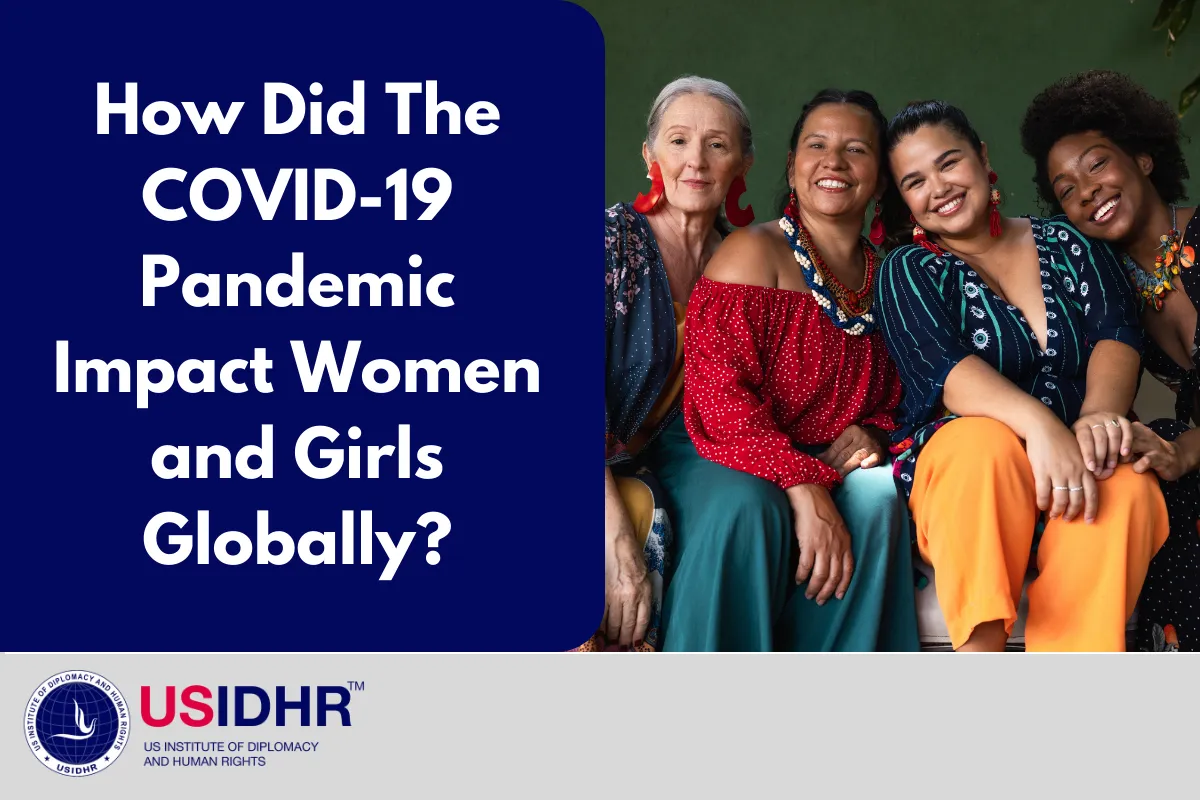
How Did The COVID-19 Pandemic Impact Women and Girls Globally?
Despite significant strides in female empowerment, women are often casualties of health crises, violent conflict, and economic crises. Studies show that 50% of refugees are women and girls, girls are 2.5 times more likely to be out of school in conflict-affected areas, and 60% of maternal mortality deaths take place during violent conflict, displacement, or natural disasters (UN Women – Headquarters, 2017). Most recently, the COVID-19 pandemic brought a public health and economic crisis that has magnified gender-based disparities. Further investigation into the impact that the coronavirus has on women and girls can provide significant insight for future development and root causes solutions. This is critical to address and protect women’s human rights globally. Evidence indicates that across the world the pandemic has disproportionately impacted women’s economic and social welfare (USGLC 2022; Madgavkar et al 2022). Specifically, causing decreased access to health care, reduced economic opportunities, and increased vulnerability to gender-based violence. We cannot continue to allow gender disparities to impede human rights. In order to address the disproportionate effects of the pandemic on women and girls, there need to be multilevel solutions.
Barriers to quality healthcare
As the pandemic has disrupted health systems, women are reporting decreased access to health care services, in particular, services to meet sexual and reproductive health needs. Over one-third of women from the UN Women’s Rapid Gender Assessment (RGAs) surveys disclosed that they had trouble accessing medical care during the pandemic (UN Women Data Hub 2021). Reduced access to reproductive services correlates with increased unwanted pregnancies and sexually transmitted infections. The United Nations Population Fund reports that there were 1.4 million unintended pregnancies as a result of disruptions in access to contraceptive services in low- and middle-income countries during the first year of the pandemic (USGLC 2022). Difficulty in accessing sanitary and health products is exceptionally concerning as sexually transmitted infections are most common in young women, ages 15-24 (UN Women Data Hub 2021). To ensure adequate access to quality healthcare, local organizations need to partner with hospitals and clinics to establish efficient healthcare product distribution and train community members to provide greater care services. An excellent example of this collaboration took place in India. Women’s community-based self-help groups in India worked with the state government to provide necessary healthcare services during the pandemic (Hay 2021). By March 2021, these groups had manufactured over 169 million masks and performed thousands of health checks. While this collaborative effort helped as a part of the COVID-19 response, it also allowed the women to gain tangible skills that can be used for future opportunities (Hay 2021).
Domestic Violence, the Shadow Pandemic
During the COVID-19 pandemic, a shadow pandemic also occurred. UN Women (2020) highlights the dreadful relationship that COVID-19 has had on violence against women and girls. This is due to increased security, health, and money tensions that have been accentuated by confined living conditions. In 2021 “globally 243 million women and girls ages, 15-49 [were] subjected to sexual and/or physical violence perpetrated by an intimate partner” (UN Women – Headquarters 2020). In some countries, there has been a 33% increase in intimate partner violence during the pandemic (Oxfam International 2021). Stay-at-home orders have also isolated women from resources and domestic violence shelters that can help them. To address this shadow pandemic there needs to be increased resources in essential services to ensure survivors’ access to support and a strong front from law enforcement to address domestic violence as a priority. To stem gender-based violence during the pandemic women’s organizations in Kashmir have created a hotline to respond to domestic violence calls. In the Maldives, hotlines have been designed to offer psychosocial support to female victims of domestic violence (Yaboke and Abdullah 2020)
Education Crisis and COVID-19
School closures as a result of stay-at-home orders have caused a devastating education crisis. A crisis that disproportionately impacted women and girls as they are 11% more likely to drop out of school than their male counterparts (USGLC 2022). Due to COVID-19 more than 20 million girls are at risk of dropping out of school and may never return (Malala Fund 2022). The increased poverty and inequality due to the pandemic are estimated to reverse the gains of global progress for girls’ education over the last twenty years (Oxfam International 2021). In a UNESCO survey of 29 countries across all regions, “two-thirds of low- and lower-middle-income countries have cut their education budgets since the onset of the COVID-19 pandemic. Only a third of upper-middle and high-income countries have reduced their budgets”(2021). Poor internet connectivity and technological access necessary for online learning exacerbates existing education inequalities between the developing and developed world. Thus detrimentally impacting girls in developing countries. Estimates also project that due to school closures 10-13 million more female child marriages will take place by 2030 (Oxfam International 2021). In developing countries, child marriage risk has increased 25% each year, and the loss of household income compounds that risk by 3% (USGLC 2022). These numbers will only increase if adequate measures are not taken to ensure a safe return to school. For these reasons, through the “Let Her Lead” program, the founder of the US Institute of Human Rights and Diplomacy, Isabelle Vladoiu has emphasized the need to empower women and girls to tackle gender-based struggles. By offering annual scholarships to vulnerable women and girls in developing countries, USIDHR educates young women on economic development practices and their human rights. Giving them the tools to identify gender-based violence and empower them to advocate for and protect their human rights.
Another key takeaway from the pandemic is the substantial impact that school closures had on working mothers. Working women with children were significantly more likely to lose their economic security than men. Twenty-eight percent of women with children aged 24-44 lost their jobs while men of the same demographic saw a 24% loss in employment. This statistic is far higher for younger women (ages 18 to 24), 56% in comparison to 44% for young men (UN Women Data Hub, 2021). As schools and daycares close, one in ten working mothers quit their jobs to support their families (Kashen, Novello and Glynn, 2021). For those that didn’t leave their jobs, there was an increase in used unpaid sick leave. To progress towards gender equality after the pandemic there needs to be immediate childcare relief and comprehensive workplace policies to prioritize the informal economy.
Austria, Costa Rica, South Korea, and several more countries implemented childcare support policies in response to the pandemic in an effort to address the childcare crisis and provide financial relief to families. Some of these policies include waiving health examination conditions, provision of childcare services for essential workers, and child care vouchers (Gromada, Richardson, and Ress 2020). Ethiopia, the Republic of Korea, and Canada took it a step further and implemented gender-responsive programs targeting childcare during COVID-19. In Ethiopia, “beneficiaries of the Urban Productive Safety Net Project (UPSNP) [received] an advanced payment while on leave from their public works obligations. UPSNP partly targets female-headed households and foresees the provision of community-based childcare services and reduced working time for women with children” (Grantham et al 2021, 20) Specifically using up to 50% of their savings to cover expenses during the pandemic. Although these programs are temporary they provide insight into long-term implications for policy solutions to support gender equality.
Disrupted Economic Participation
The collapse of the child care sector and the parallel economic crisis have drastically impacted women’s workforce progress. Overall global female labor force participation dropped 4.2% at the beginning of the pandemic in 2020, in comparison to a 3% drop from their male counterparts. Which resulted in an $800 billion loss in income for women worldwide (USGLC 2022).
Globally in 2021, there were 13 million fewer women employed than in 2019, and in some countries such as India, Japan, and the UK female employment is still below pre-pandemic levels (UN Women Data Hub 2021; Barua 2022). According to Oxfam International women are predominantly employed in the informal economy and this sector has been hit hard by the pandemic (2021). Within the first month of the pandemic income for women in the informal economy saw a 60% drop, resulting in 47 million women and girls being pushed into extreme poverty (Madgavkar et al 2022).
Conclusion:
Women and girls continue to suffer as casualties of the global coronavirus pandemic, as they are disproportionately affected by barriers to quality health care, an education crisis, gender-based violence, and economic factors. It does not have to be this way. As the COVID-19 pandemic illustrates the uneven global progress toward gender equality it is clear that policymakers, business leaders, and grassroots organizers need to act to address societal disparities. Not only to address the effects of the pandemic and economic growth but to empower women.
In addition to supporting vulnerable women and girls pursuing education and providing them the tools to advocate for their human rights, USIDHR offers courses in Human Rights Education Training. Students undertake an 8 module human rights certification program that teaches them the necessary skills and information to make a change in the world as a human rights consultant. If you’re interested in becoming a human rights advocate, then click here to access the registration page.
Reference list:
“5 Ways Women and Girls Have Been the Hardest Hit by Covid-19.” Oxfam International, July 16, 2021. https://www.oxfam.org/en/5-ways-women-and-girls-have-been-hardest-hit-covid-19.
Barua, Akrur. “Gender Equality, Dealt a Blow by Covid-19, Still Has Much Ground to Cover.” Deloitte Insights. Deloitte, January 27, 2022. https://www2.deloitte.com/us/en/insights/economy/impact-of-covid-on-women.html.
“Covid-19 and Ending Violence against Women and Girls.” UN Women – Headquarters. Accessed May 17, 2022. https://www.unwomen.org/en/digital-library/publications/2020/04/issue-brief-covid-19-and-ending-violence-against-women-and-girls.
“Covid-19 Brief: Impact on Women and Girls.” USGLC, May 12, 2022. https://www.usglc.org/coronavirus/women-and-girls/.
Frederiksen, Brittni, and Usha Ranji. “Women, Work, and Family during COVID-19: Findings from the KFF Women’s Health Survey.” KFF, April 15, 2021. https://www.kff.org/womens-health-policy/issue-brief/women-work-and-family-during-covid-19-findings-from-the-kff-womens-health-survey/.
“Girls’ Education and COVID-19: New Factsheet Shows Increased Inequalities for the Education of Adolescent Girls.” UNESCO, June 15, 2021. https://en.unesco.org/news/girls-education-and-covid-19-new-factsheet-shows-increased-inequalities-education-adolescent.
Grantham, Kate, Leva Rouhani, Neelanjana Gupta, Martha Melesse, Diva Dhar, Soumya Kapoor Mehta, and Kanika Jha Kingra. “Evidence Review of the Global Childcare Crisis and the Road for Post …” Bill & Melinda Gates Foundation, 2021. https://docs.gatesfoundation.org/Documents/Policy_Summary_Global_Childcare_Crisis_and_the_Road_Ahead_for_COVID-19_Recovery_and_Resilience_ENGLISH.pdf.
Gromada, Anna, Dominic Richardson, and Gwyther Rees. “Childcare in a Global Crisis: The Impact of Covid-19 on Work and Family Life.” UNICEF, 2020. https://www.unicef-irc.org/publications/1109-childcare-in-a-global-crisis-the-impact-of-covid-19-on-work-and-family-life.html.
Hay, Katherine. “What Are Women’s Empowerment Collectives and How Are They Helping Women Weather Covid-19?” Bill & Melinda Gates Foundation, April 2, 2021. https://www.gatesfoundation.org/ideas/articles/womens-empowerment-collectives-covid.
Kashen, Julia, Amanda Novello, and Sarah Jane Glynn. “How Covid-19 Sent Women’s Workforce Progress Backward.” Center for American Progress, November 9, 2021. https://www.americanprogress.org/article/covid-19-sent-womens-workforce-progress-backward/.
“Malala Fund Releases Report on Girls’ Education and Covid-19.” Malala Fund, April 13, 2022. https://malala.org/newsroom/malala-fund-releases-report-girls-education-covid-19.
Madgavkar, Anu, Olivia White, Mekala Krishnan, Deepa Mahajan, and Xavier Azcue. “Covid-19 and Gender Equality: Countering the Regressive Effects.” McKinsey & Company, April 13, 2022. https://www.mckinsey.com/featured-insights/future-of-work/covid-19-and-gender-equality-countering-the-regressive-effects.
“Women and Girls Left behind: Glaring Gaps in Pandemic Responses.” UN Women Data Hub, December 16, 2021. https://data.unwomen.org/publications/women-and-girls-left-behind-glaring-gaps-pandemic-responses.
“Women in Crisis - Vulnerable to Risk, Vital & Recovery.” UN Women – Headquarters, August 18, 2017. https://www.unwomen.org/en/digital-library/multimedia/2017/8/photo-women-in-crisis.
Yayboke, Erol, and Hareem F. Abdullah. “Elevating Women Peacebuilders amidst Covid-19.” Center for Strategic and International Studies (CSIS), 2020. http://www.jstor.org/stable/resrep25662.

